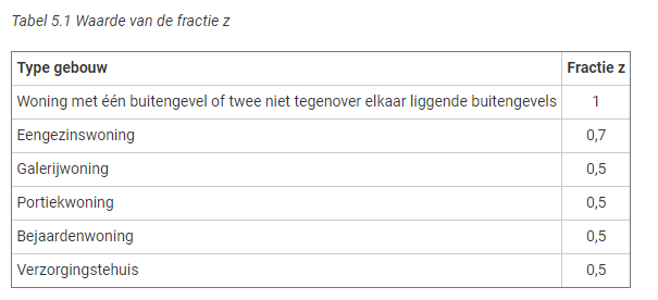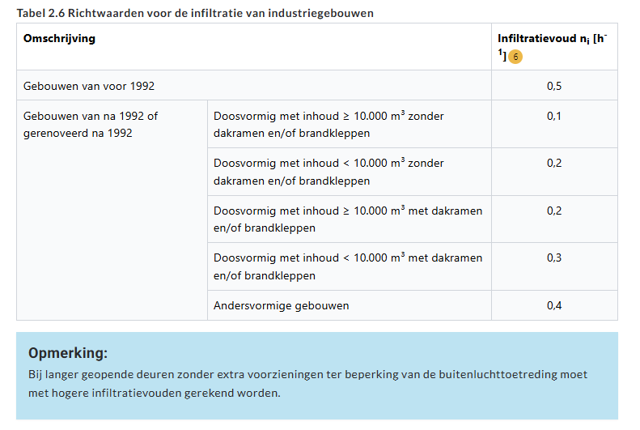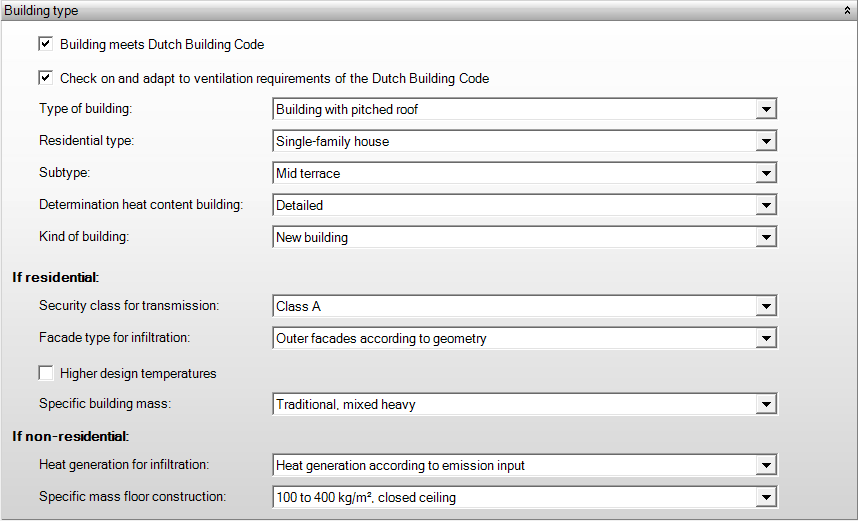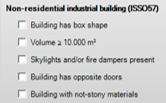Building requirements
The template ‘building requirements’ contains a combination of requirements regarding the Dutch Building Code, transmission losses, and other building-specific properties. It also includes these properties of the ground, which is important in case you would define a floor on sand.
In this template data is specified concerning both residential and non-residential buildings. The relevant data, which depends on the Use as specified in the template ‘Use’, are used in the calculations.
Building type
Building meets Dutch Building Code
- Warmteverlies
A building complies with the Dutch Building Code if it has been built in or after 1992, or if it has been renovated and meets the requirements of the Dutch Building Code. One can choose between the Dutch Building Codes of 2003 and 2012; the latter is used in the calculations by default.
For ISSO 2017: If the building meets the Dutch Building Code, the infiltration is calculated based on the qv;10 value by default. If the building does not meet this code, the infiltration is determined based on different tables which means more infiltration will be surcharged. In this case no verifications are performed on the minimum ventilation requirements of the Dutch Building Code also; the specified flow rates for ventilation are used in the calculations.
Publications
ISSO Publicatie 53, paragraaf 4.7.1
ISSO Publicatie 57, paragraaf 3.7.1
Infiltration heat loss
Check ventilation requirements of the Dutch Building Code
- Warmteverlies
If this box is checked a verification of the ventilation requirements of the Dutch Building Code is performed. By default, this option is activated and we recommend the keep it at such. In special situation this option may be deactivated. In this case the software does not verify whether the specified flow rates comply with the minimum ventilation requirements, and these minimum ventilations requirements are not used automatically in case no flow rates have been defined.
Type of building
- Warmteverlies
- EPG
The type of building is used in the EPG calculations to determine the infiltration. For this purpose a correction factor is determined based on NEN 8088, Table 9.
- Building with pitched roof, ground-based single-layer buildings, single-family houses, or offices with a pitched roof. Ftype=1
- Building with flat roof, ground-based single-layer buildings, single-family houses or offices with a flat roof. Ftype=0.77
- Multi-storey building, standard; ftype=0.15, full façade inner-galary on 1-side; 0.48, double layered façade with interrupted interspace; ftype 0.46, double layered façade with continious interspace; ftype=0.15, multilayer utility buildings, apartment- or portico houses
For buildings that do not meet the airtightness requirements of the Building Code, a correction factor applies for the influence of wind pressure-induced infiltration. For the building-dependent wind pressure distribution, see Table 4.5 in ISSO 51 (2017) or Table 2.6 in ISSO 51 (2023).
Publications
Specific heat loss due to infiltration
Calculation value of heat emitter efficiency
Subtype
- Warmteverlies
- EPG
The subtype is used to determine the type of construction which is applied in the heat loss calculation. The type of construction is used to determine the heat loss to adjacent buildings, and to determine the CZ-value for computing the transmission losses to adjacent buildings.
The subtype is used in EPG calculations to determine the specific air tightness and the corresponding correction factor.
When a building with a pitched roof or flat roof is chosen as the building type:
- Mid terrace, applicable to both ground-based and multilayer buildings;
- End of terrace, applicable to both ground-based and multilayer buildings;
- Detached, pitched roof, applicable to ground-based buildings with pitched roof;
- Detached, mono-pitched, applicable to ground-based buildings with mono-pitched roof;
- Detached, flat roof, applicable to ground-based buildings with flat roof.
When choosing for multilayered building under type of building, the following options are given: The façade type is used to calculate the fraction Z, which indicates the fraction of infiltration included in determining the connection demand.
- Outer facade according to geometry;
- 1 outer facade;
- 2 non opposite outer facades;
- Opposite outer facades.
Publications
Calculation value for specific air permeability and correction for the building type
Facade type
- Warmteverlies
- EPG
When Multi-story building is selected under Building type, a facade type can be chosen.
Determine heat content building
- Warmteverlies
To determine the time constant of a building, the heat capacity can be determined in the following two ways:
- Flate rate: fill in value at Thermic mass;
- Detailed: the timeconsistant is automatically determined by the construction; At Input under Construction choose Materiallayer.
Publications
ISSO Publicatie 53, paragraaf 2.6.1
Determine heat content building
Thermal mass
- Warmteverlies
To determine the heat volume of a flat-value building, there are 4 options (ISSO 2024).
- Heavy: heat value of 75 Wh/(m³.K);
- Average heat volume of 55 Wh/(m³.K);
- Light: heat volume 35 Wh/(m³.K);
- Very light: heat value of 15 Wh/(m³.K).
Publications
Kind of building
- Warmteverlies
By specifying the kind of building, the additional factor on the U-value of constructions due to thermal bridges can be determined as follows:
- New building with provisions against thermal bridges: adds an additional 0.02 W/m².K to the U-value.
- New building: adds an additional 0.05 W/m².K to the U-value.
- Building with insulation and discontinuous insulation: adds an additional 0.15 W/m².K to the U-value.
- Surcharge already included in the U-value (according to NTA): no additional surcharge (added in ISSO 51 (2023)).
- Other situations: add an additional 0.10 W/m².K to the U-value.
Publications
ISSO Publicatie 53, paragraaf 3.2 tabel 3.1
Specific heat loss of the building to the outdoor air
Measured qv,10
In a heat loss calculation according to ISSO 51 (2023), you can input the measured qv,10 of the building in dm³/s (cubic decimeters per second).
If a qv10 value is known you can choose this option.
The third option is “Flat rate”. Infiltration is calculated, the Year of construction is important in this situation.
Houses/residential buildings
Reliability class of transmission loss
- Warmteverlies
The security class indicates the measure of certainty regarding the occurrence of a lower inside temperature in an adjacent parcel. Four different security classes have been defined:
- Class A stands for maximum security. The design indoor temperature and heating rate are guaranteed for vacancy, absence, or abnormal behaviour of all neighbours. Therefore, a higher transmission loss is used for this class in the calculations.
- Class B represents a reduced security. The design indoor temperature and heating rate are guaranteed for at most 50% vacancy, absence, or abnormal behaviour of all neighbours, and they are guaranteed in case the residence has a maximum of one neighbour.
- Class C stands for low security. The design indoor temperature and heating rate are guaranteed for vacancy, absence, or abnormal behaviour of maximum one adjacent building. Therefore, a low transmission loss is used for this class in the calculations
- Class D represents no security. The design indoor temperature and heating rate are guaranteed when all adjacent houses are always at the same temperature level as the residence which is considered. Therefore, no transmission loss is used for this class in the calculations.
The type and subtype of the building are used to compute a correction factor for the security class, called CZ-value. If security class B, C, or D has been chosen, additional measures are required to prevent the heat loss to adjacent rooms exceeds the available thermal power.
The computed CZ-value is shown on the first page heat loss report. If this CZ-value is included in the calculation of transmission loss, a “+” appears in the column “Cz” in the output.
| Security Class | ||||
| A | B | C | D | |
| Detached | NA | NA | NA | NA |
| Semi-detached | 1.00 | 1.00 | 1.00 | 0.00 |
| Terraced Townhouse | 1.00 | 0.50 | 0.50 | 0.00 |
| Stacked construction with 2 neighbours | 1.00 | 0.50 | 0.50 | 0.00 |
| Stacked construction with 3 neighbours | 1.00 | 0.66 | 0.33 | 0.00 |
| Stacked construction with 4 or more neighbours | 1.00 | 0.50 | 0.25 | 0.00 |
Table15: Determination of Cz-value
Publications
Uncertainty class for heat loss to adjacent dwellings/residential buildings
From ISSO 2024 it’s not possible to choose a class. The CZ value in the calculation is found in the report. Used values are found in table 2.16 ISSO 51 2024.
Dwelling type
- Warmteverlies
- EPG
The dwelling type is used in the heat loss calculation to determine the temperature of adjacent buildings, and to determine the correction factor for the security class. In the EPG calculation, the dwelling type is used to determine the EPC requirement.
Publications
Energiezuinigheid, nieuwbouw
Number of adjacent dwellings
- Warmteverlies
Number of adjacent dwellings to which the buildings in which this template is applied are connected. Only applicable when the apartment or residential building option is chosen for the type of dwelling.
Number of dwellings
- EPG
Number of dwellings present in a residential building. Applicable only when the residential building option is chosen for the type of dwelling.
Higher design indoor temperatures
- Warmteverlies
For modern, well-insulated homes, higher design indoor temperatures can be considered for living rooms and circulation areas. This means a setpoint 2K higher than standard.
Publications
Design indoor temperature
From ISSO 2024 there’s no choose: standard indoor temperature is always higher.
Specific building mass
- EPG
In housing, the specific internal heat capacity is determined based on the specific building mass. Subsequently the utility factors for heat gain are computed.
- Traditional, mixed heavy, massive (over 100 kg/m2) interior cavity walls, building separating walls, and floors;
- Mixed light, light (less than 100 kg/m2) interior cavity walls, building separating walls, and floors;
- Wood framed, light interior cavity walls, building separating walls, and floors;
- Unknown, this is not allowed for the EPG calculation.
Publications
Utilization factor for heat gains (warmtebehoefte)
Facades type for infiltration
- Warmteverlies
Only for ISSO 2017:
The façade type is used to calculate the fraction Z, which indicates the fraction of infiltration included in determining the connection demand.
- 1 outer façade or 2 non-opposite outer facades gives a fraction Z of 1;
- Opposite outer façade gives a fraction Z of 0.7;
- Outer facades according to geometry gives a Z fraction according to the geometric model. Based on the geometry, it is determined whether the building belongs to option 1 outer façade or 2 non-opposite outer facades, or Opposite outer façade (option 1 or 2).
This value is used for the connected load and is taken from Table 5.1 in ISSO 51.

Publications
Heat loss due to outdoor air ingress
If non-domestic
Heat generation for infiltration
- Warmteverlies
- Separate heat generators per zone: the infiltration for calculating the connection demand charged in the rooms, is completely surcharged;
- Non-separate heat generators per zone: the infiltration for calculating the connection demand charged in the rooms, is surcharged at half (fraction Z = 0.5);
- Heat generation according to emission input issue: in this case the specified distribution system which is used for the emissive devices (generators are not assigned in the heat loss calculation). If multiple distribution systems have been specified, the first option is used in the calculation; the second option is used also, but only in a very few distribution systems.
Publications
Heat loss due to outdoor air ingress
Specific mass floor construction
- EPG
In non-residential buildings the specific mass of the floor construction is used to determine the specific internal heat capacity, and subsequently the utility factors for heat gain.
Publications
Non-residential industrial building (ISSO57)
ISSO 57 industial contains a table for infiltration: table 2.6.
This contains values for the infiltration of several buildings.

The first three bullits are applied to find the right value in the table.
I you choose “Building has opposite doors” the infiltration wil be 0,2LW higher.
If you ticke the last checkbox “Building with not-stony materials” the efeect will be that there will be no correction on the outside temperature. Not select this checkbox and for ISSO 57 industrial will have a correction on the outside temperature depending on the calculated time constant building like the other ISSO’s.
Ground settings
The floor level of the lowest storey (height, z = 0 mm) is defined as a floor directly on the ground by default. The properties used for such floors can be specified here. The floor (and any other building component which is adjacent to the outside air according to the geometry) can be linked to another demarcation in Properties>Building parts. For example, this may be a crawl space instead of a floor on sand.
Thermal conductivity ground
- Gebouwsimulatie
- Koellast
All floors which have been drawn on the level with height, Z-value “0”, are given the default demarcation floor (directly) on ground. The following predefined soil type can be chosen from:
- User defined: the lambda of the ground can be specified manually;
- No conduction has a lambda of 0.000 W / (m.K);
- Very dry sand has a lambda of 0.300 W / (m.K);
- Dry sand has a lambda of 0.800 W / (m.K);
- Clay has a lambda of 1.000 W / (m.K);
- Wet sand has a lambda of 1.400 W / (m.K);
- Very wet sand has a lambda of 1.900 W / (m.K);
- High conductivity has a lambda of 300.000 W / (m.K). This possibility of λ=300 W / (m.K) is used to set a temperature on the outside of a wall.
Publications
Thermal conductivity ground
Temperature
- Gebouwsimulatie
- Koellast
This is the average temperature of the ground at 3 metres depth below the floor level. The ground temperature at a depth of 5 m can be applied as a constant throughout the year: θg = 10 °C.
Publications
Soil temperature
Ground water level
- Warmteverlies
The ground water level is required to determine the ground water factor Gw. This factor is used to calculate the heat loss in floors and walls which are in direct contact with the ground. On can choose from:
- On floor level (Gw = 3.0)
- 0 to 1 metre below floor level (Gw = 1.15)
- Deeper than 1 metre below floor level (Gw = 1.0)


